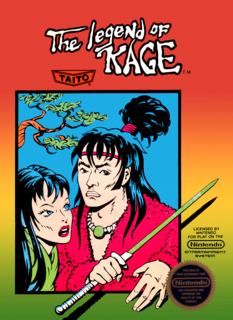Short and repetitious. Short and repetitious. Short and repetitious....
Gameplay is as straightforward as the plot. Once the hero's girl is kidnapped, the player must dash across a forest, throwing stars and slashing his blade as ninja and fire monks attempt to stop him with their own stars, blades, and magic potions. Along the way, various power-ups can be found such as those that increase your firepower as well as the amount of damage you can take, make you invincible for a short while, and a magic scroll that strikes down all enemies on screen as they appear for a number of seconds. Advancement through the level is not entirely clear, although as best as I can tell it occurs after you've defeated a certain number of enemies. At that point, a red-colored fire monk appears which you must defeat, which admittedly isn't hard to do as this enemy is identical to the standard, blue-colored fire monk in all but appearance. The player then attempts to sneak into the enemy compound by hiding in a nearby river and then scaling up its massive walls via long-jumps. Once the hero enters the compound, he must race to the top to rescue the girl, at which point she gets kidnapped...again. The player then descends back into the forest to battle a boss character, rinse, repeat. There are a total of four levels which are identical to each other save for seasonal setting (which does little more but change the color of the backdrop from green to orange to white) and final boss characters (which for the most part remain fundamentally the same), and each level contains five sub-levels: a running forest battle, hiding in a river, scaling the compound walls, rescue the girl and the boss confrontation. Controls are simple and for the most part responsive: jumping is done by pressing up on the directional pad, and stars are thrown either forward, backwards, upwards or downwards while the sword can be used on nearby enemies. Graphics and sound are decent for the era, with reasonably defined graphics and a good midi score with sound effects. Overall, an entertaining and addictive game even if it is a little on the repetitive side.

